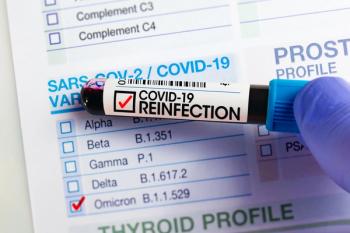
Atezolizumab, Bevacizumab Combination May Increase Risk of Cardiac Toxicity in Patients with Liver Cancer
Quitting treatment may significantly improve severe hypertension in patients with hepatocellular carcinoma.
Combination treatment with atezolizumab and bevacizumab nearly doubled the percentage of probable cases of pulmonary arterial hypertension (PAH)—a severe and progressive disease that leads to degraded pulmonary arteries and heart failure—in patients with hepatocellular carcinoma (HCC), according to a recent study published in Scientific Reports.
Approximately 6.7% of patients were diagnosed with PAH prior to starting atezolizumab and bevacizumab, but after treatment, the percentage of patients with probable PAH increased to 12.4%.
“To the best of our knowledge, this is the first report showing that Atez/Bev may adversely affect PAH; this adverse effect can be ameliorated by drug discontinuation,” the study authors wrote.
PAH is a complication associated with HCC, the foremost type of liver cancer, which has since become a leading cause of cancer-related death globally. The combination of atezolizumab, a fully humanized anti-programmed death-ligand 1 antibody, and bevacizumab, a vascular endothelial growth factor (VEGF)-targeting antibody, is the standard first-line therapy for HCC.
Investigators used computed tomography (CT) to evaluate the effect of atezolizumab and bevacizumab on PAH in 113 patients in Japan. The team used the CT scan to measure the diameter of their main pulmonary artery (mPA-D) and the diameter of the ascending aorta (aAo-D), which are PAH biomarkers linked to cardiac toxicity and adverse events (AEs), before and after treatment.
Current Japanese guidelines list probable PAH as having an mPA-D of 33 mm or more. Suspicious PAH is considered an mPA-D of 29 mm or more (or an mPA-D/aAo-D of 1.0 or more), and values below 29 mm reflect non-suspicious PAH.
The results of their analysis support guideline recommendations, according to the authors. Upon analysis, having an increased value for mPA-D and mPA-D/aAo-D was associated with suspicious PAH (average 31.7 mm and 1.9 mm, respectively) compared to non-suspicious (24.9 mm and 2.9). Patients who were older with advanced HCC were likely to have significantly larger mPA-D and mPA-D/aAo-D after taking atezolizumab and bevacizumab, according to the results analysis.
“In patients with advanced HCC and elderly patients, the increment of pulmonary artery diameter should be monitored carefully,” the investigators wrote.
Increased (increment) mPA-D can be linked to respiratory/heart failure and poor prognosis. The team even observed that mPA-D was associated with post-treatment respiratory/heart failure.
mPA-D and mPA-D/aAo-D were also significantly lower among patients who stopped continuous treatment with mPA-D and mPA-D/aAo-D (or any other molecular-targeted drugs), which highlights the entire role of molecular-targeted drugs on PAH, according to the study authors.
Women appeared to have more idiopathic and familiar forms of PAH. It supports previous research that found women to be 1) more at risk of pulmonary hypertension and 2) prone to changes in estrogen metabolites that may incite PAH pathogenesis.
The study contains some limitations, including the retroactive analysis of data that were only collected from a single center. Further, the study does not evaluate data taken via RHC or echocardiography.
Generally, investigators recommend proactive use of CT for PAH screening, which can lead to earlier diagnosis that allows health care professionals to assess whether atezolizumab and bevacizumab should be discontinued, or whether it’s necessary to add treatment for PAH.
Reference
Kondo T, Fujiwara K, Nakagawa M, et al. Estimation of the effect of atezolizumab plus bevacizumab on pulmonary arterial hypertension using computed tomography in HCC patients. Sci Rep. 2023; 13:11524. doi: 10.1038/s41598-023-38377-2
Newsletter
Stay informed on drug updates, treatment guidelines, and pharmacy practice trends—subscribe to Pharmacy Times for weekly clinical insights.


















































































































































































































